
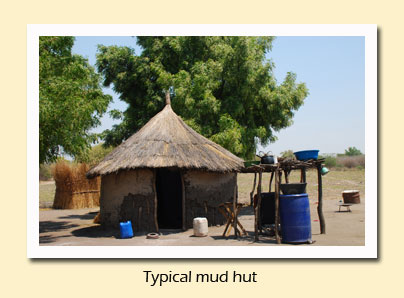 Siankaba Village
Siankaba Village
Right after breakfast, we took the shuttle boat over to the reception area and met our guide, Richard, who would give us a full walking tour of several local villages, the biggest of which was Siankaba.
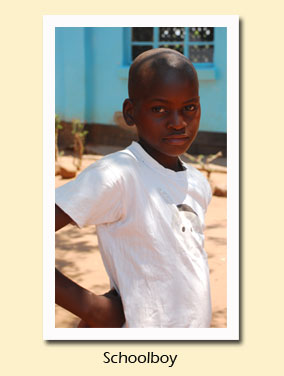 We walked about 20 minutes to Siankaba Village. We saw the church, which was built by missionaries and had doubled as a preschool until the new school was completed. We toured the beautiful new two-room preschool and the new house for the schoolmaster (Milindi). Workers were completing the final touches before the move-in date that weekend.
We walked about 20 minutes to Siankaba Village. We saw the church, which was built by missionaries and had doubled as a preschool until the new school was completed. We toured the beautiful new two-room preschool and the new house for the schoolmaster (Milindi). Workers were completing the final touches before the move-in date that weekend.
The village itself is like so many of the villages we had driven by. Mud houses, thatched roofs, outdoor kitchen areas with open fire pits for cooking. But to see it up close, and to have it explained by Richard, who actually lives in the village, was invaluable.
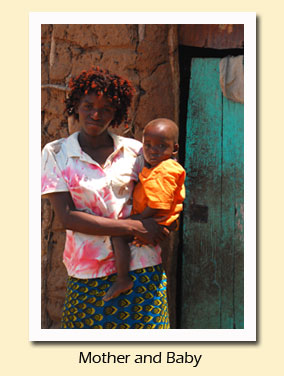 We got to meet the hotel's master chef, who lives in one of the huts and owns the largest garden and a small mud booth that is the village store (with just a few spare items in it). I was amazed that the creator of such beautifully presented culinary delights actually lived there, and had nothing more than an open fire for his own cooking. "How did he learn to cook like he does?" I asked. Mostly on the job, I was told, picking up everything he could from visiting chefs.
We got to meet the hotel's master chef, who lives in one of the huts and owns the largest garden and a small mud booth that is the village store (with just a few spare items in it). I was amazed that the creator of such beautifully presented culinary delights actually lived there, and had nothing more than an open fire for his own cooking. "How did he learn to cook like he does?" I asked. Mostly on the job, I was told, picking up everything he could from visiting chefs.
Richard showed us the blacksmith's workshop, which was nothing more than a fire pit under a tree, shaded by cloth and plastic. Two hand bellows for pumping up the fire. The blacksmith made spades for digging.
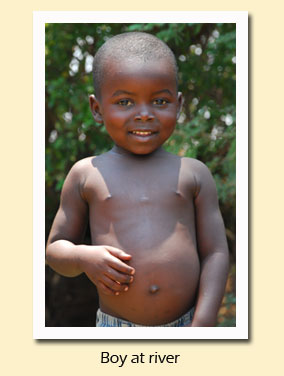 Richard showed us his house, which he and his wife had decorated with animals painted on the outside walls and hanging ornaments cut from soda cans. He told us how the huts were made. "The men build the structure with sticks. The women put on the mud." The roofs are made from tall grass. There are pit toilets (long-drops) with thatched walls for privacy, and another thatched privy for bathing. Water is collected from the river or from a pump. "Not unlike camping, really," I remarked. Richard couldn't believe it when I explained to him that back home, we left our houses with electricity and running water to go to a place like this for vacation.
Richard showed us his house, which he and his wife had decorated with animals painted on the outside walls and hanging ornaments cut from soda cans. He told us how the huts were made. "The men build the structure with sticks. The women put on the mud." The roofs are made from tall grass. There are pit toilets (long-drops) with thatched walls for privacy, and another thatched privy for bathing. Water is collected from the river or from a pump. "Not unlike camping, really," I remarked. Richard couldn't believe it when I explained to him that back home, we left our houses with electricity and running water to go to a place like this for vacation.
The elementary school is attended by kids from several different villages. When we got there, it was recess and the kids were all outside. They immediately came to us and posed for photos — one swarm around me, another around Kate. "One at a time," I insisted. So they took turns telling me their names and smiling for a photo. I repeated each of their names back to them, struggling with some of the African names, chuckling at some of the familiar names, such as "Elvis." They were so delightful, it was hard to leave them.
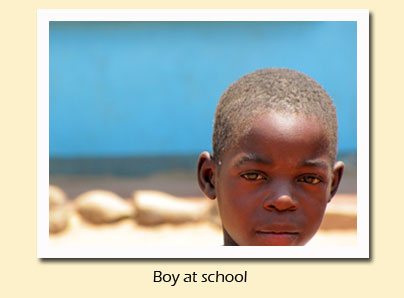 The next village over had a clinic that was used for people miles around. In fact, there was a small house for relatives to stay, since some people had to travel a long distance. The clinic included two wards, one for women, one for men, which were just rooms with a few cots. There was a Labour Room, with a table with stirrups. And the nurse's office, for intake interviews. There were no patients in any of the rooms, but in the shaded area in front, several people lay or sat, either waiting to be seen or just preferring the cool concrete to the hot rooms.
The next village over had a clinic that was used for people miles around. In fact, there was a small house for relatives to stay, since some people had to travel a long distance. The clinic included two wards, one for women, one for men, which were just rooms with a few cots. There was a Labour Room, with a table with stirrups. And the nurse's office, for intake interviews. There were no patients in any of the rooms, but in the shaded area in front, several people lay or sat, either waiting to be seen or just preferring the cool concrete to the hot rooms.
At the end of our tour, we walked back to the river where a dug-out canoe and cold orange juice was awaiting us. It was a slow, peaceful ride back to the hotel with the boat driver steering us through shallow waters like a gondolier.
